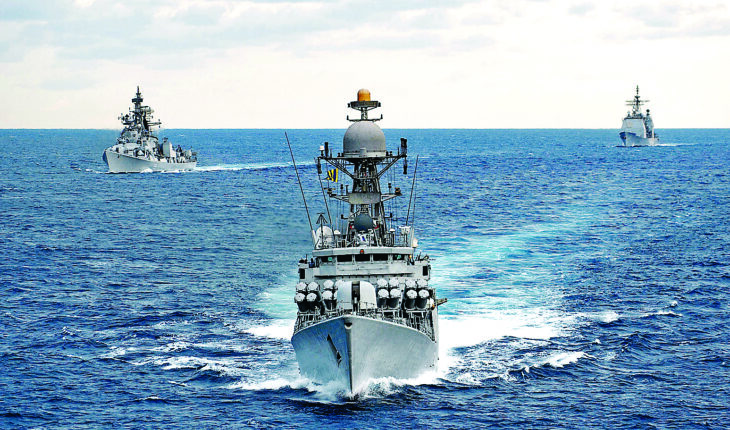Abhijit Singh explores how new initiatives may help generate intraregional synergy via Indian Ocean,The legendary military theorist, Sun Tzu, is once said to have observed that the critical element in battle was foreknowledge, but that it “could not be elicited from spirits, nor from gods, nor by analogy with past events, nor from calculations”. As the great Chinese general saw it, foreknowledge could only be gathered with specialised tools and by men who knew the enemy well. A prior reading of the adversary and the theatre of battle, the master tactician asserted, could decisively shift the balance of fortune in war.
In the modern maritime arena, war is a more complex proposition than in the days of Sun Tzu, but ‘foreknowledge’ is still critical. Today, the enemy at sea is often unrecognisable — a terrorist, a pirate, a criminal or a sea robber — an invisible presence that lurks behind regular actors such as fishermen and port workers. Law enforcement agencies today need to be a lot more vigilant, highly reliant on high-grade sensors and communication networks that observe and track suspicious movements, sharing information in real time. Practitioners describe this state of enhanced consciousness as maritime domain awareness.
Of late, the Indian Navy has been on a drive to improve domain awareness in the Indian Ocean. The Navy is seeking to expand India’s surveillance footprint by setting up radar stations in the Maldives, Myanmar and Bangladesh; Mauritius, the Seychelles and Sri Lanka have already integrated into the wider coastal radar chain network. The Indian Navy’s efforts seem focused primarily on monitoring Chinese activity in the Eastern Indian Ocean, particularly in the seas around the Andaman and Nicobar islands. Since June 2020, when the Indian Army and the People’s Liberation Army clashed in Galwan in northern Ladakh,
Indian maritime planners have been wary of the possibility of a greater Chinese presence in the eastern littorals. In recent months, India’s P-8I aircraft have scoured the near-seas for People’s Liberation Army Navy (PLAN) submarines, and Indian naval ships have patrolled the Andaman Seas and eastern chokepoints to deter any maritime adventurism by Beijing.
Neighbourhood synergies
But maritime domain awareness is also generating cooperative synergies in the neighbourhood. There are reports that seven Indian Ocean countries — Bangladesh, Myanmar, Indonesia, Sri Lanka, the Maldives, Mauritius and the Seychelles — will soon post Liaison Officers at the Indian Navy’s Information Fusion Centre-Indian Ocean Region in Gurugram. . France already has an officer at the IFC, and four other Indo-Pacific navies — Australia, Japan, the U.K and the U.S. — have also agreed to position officers at the centre, fast emerging as the most prominent information hub in the Eastern Indian Ocean.
New Delhi is also upping its engagement in the Western Indian Ocean by positioning a Liaison Officer at the Regional Maritime Information Fusion Centre (RMIFC) in Madagascar. Established under the auspices of the Indian Ocean Commission that India joined recently as an ‘observer’, the RMIFC is a key centre of maritime information in the Western Indian Ocean. India has also posted an officer at the European Maritime Awareness in the Strait of Hormuz (EMASOH) in Abu Dhabi to assist in the monitoring of maritime activity in the Persian Gulf and the Strait of Hormuz.
The French connection
Delhi’s moves in the Western and South Western littorals have been facilitated by France, a key Indian Ocean power and a critical partner for India in the region. Having signed a logistics agreement with New Delhi in 2019, Paris is keen for a stronger partnership in the maritime commons. France has been instrumental in securing ‘observer’ status for India at the Indian Ocean Commission, and is pushing for greater Indian participation in security initiatives in the Western Indian Ocean. From an operational perspective, however, the Indian Navy’s priority remains South Asia, where the naval leadership remains focused on underwater domain awareness in the Eastern Indian Ocean.
There is concern among maritime watchers that the PLAN may be poised to develop a generation of quieter submarines that would be hard to detect in the near-seas. Three years after the Chinese staged a breakthrough in submarine propulsion by successful testing shaftless rim-driven pump-jets, analysts fear that the next generation of PLAN nuclear submarines could be stealthier than ever, capable of beating adversary surveillance. The recent discovery of a Chinese unmanned underwater vehicle close to a southern Indonesian island suggests that China may already be mapping the undersea terrain in the approaches to the Indian Ocean Region, with a view to advance submarine operations.
Not surprisingly, India has moved to expand its underwater detection capabilities in the Eastern chokepoints. In a bid to enhance surveillance over sensitive sea spaces, the Indian Navy has inducted two Sea Guardian drones on lease from the United States. With nine operational P-8I aircraft, the Navy’s coverage of the Bay of Bengal littoral is already considerable. With nine more aircraft planned to be inducted — three under an ongoing contract from the U.S. and six as part of a deal being negotiated with Washington — the surveillance footprint is set to further grow. Speculation abounds that New Delhi might also partner Japan in installing an array of undersea sensors near the Andaman Islands to help detect Chinese submarines.
India’s initiatives in the maritime domain are motivated by more than just strategic considerations. Indian decision makers recognise the need for cooperative tools to fight transnational crime in the littorals. White shipping agreements with 21 countries in the Indian Ocean have enabled a comprehensive picture of maritime traffic, even as efforts are under way to help smaller island states build capacity to combat regional threats. India’s military satellite (GSAT-7A) may soon facilitate a real time sharing of maritime information with partners. These endeavours, naval officers say, are a manifestation of Security and Growth for All in the Region (SAGAR), Prime Minister Narendra Modi’s philosophical mantra that advances the idea of India as a ‘security provider’ and ‘preferred partner’ in the Indo-Pacific region.
Indian initiatives, however, are yet to bring about an alignment of objectives and strategies of regional littoral states. While cooperative information sharing allows for a joint evaluation of threats, countries do not always share vital information timeously. To bring real change, India must ensure seamless information flow, generating operational synergy with partners, and aim to expand collaborative endeavours in shared spaces. That would be the real test of the maritime domain awareness ‘game-changing’ potential.
Abhijit Singh is a retired naval officer and Senior Fellow at the Observer Research Foundation in New Delhi
In the modern maritime arena, war is a more complex proposition than in the days of Sun Tzu, but ‘foreknowledge’ is still critical. Today, the enemy at sea is often unrecognisable — a terrorist, a pirate, a criminal or a sea robber — an invisible presence that lurks behind regular actors such as fishermen and port workers. Law enforcement agencies today need to be a lot more vigilant, highly reliant on high-grade sensors and communication networks that observe and track suspicious movements, sharing information in real time. Practitioners describe this state of enhanced consciousness as maritime domain awareness.
Of late, the Indian Navy has been on a drive to improve domain awareness in the Indian Ocean. The Navy is seeking to expand India’s surveillance footprint by setting up radar stations in the Maldives, Myanmar and Bangladesh; Mauritius, the Seychelles and Sri Lanka have already integrated into the wider coastal radar chain network. The Indian Navy’s efforts seem focused primarily on monitoring Chinese activity in the Eastern Indian Ocean, particularly in the seas around the Andaman and Nicobar islands. Since June 2020, when the Indian Army and the People’s Liberation Army clashed in Galwan in northern Ladakh,
Indian maritime planners have been wary of the possibility of a greater Chinese presence in the eastern littorals. In recent months, India’s P-8I aircraft have scoured the near-seas for People’s Liberation Army Navy (PLAN) submarines, and Indian naval ships have patrolled the Andaman Seas and eastern chokepoints to deter any maritime adventurism by Beijing.
Neighbourhood synergies
But maritime domain awareness is also generating cooperative synergies in the neighbourhood. There are reports that seven Indian Ocean countries — Bangladesh, Myanmar, Indonesia, Sri Lanka, the Maldives, Mauritius and the Seychelles — will soon post Liaison Officers at the Indian Navy’s Information Fusion Centre-Indian Ocean Region in Gurugram. . France already has an officer at the IFC, and four other Indo-Pacific navies — Australia, Japan, the U.K and the U.S. — have also agreed to position officers at the centre, fast emerging as the most prominent information hub in the Eastern Indian Ocean.
New Delhi is also upping its engagement in the Western Indian Ocean by positioning a Liaison Officer at the Regional Maritime Information Fusion Centre (RMIFC) in Madagascar. Established under the auspices of the Indian Ocean Commission that India joined recently as an ‘observer’, the RMIFC is a key centre of maritime information in the Western Indian Ocean. India has also posted an officer at the European Maritime Awareness in the Strait of Hormuz (EMASOH) in Abu Dhabi to assist in the monitoring of maritime activity in the Persian Gulf and the Strait of Hormuz.
The French connection
Delhi’s moves in the Western and South Western littorals have been facilitated by France, a key Indian Ocean power and a critical partner for India in the region. Having signed a logistics agreement with New Delhi in 2019, Paris is keen for a stronger partnership in the maritime commons. France has been instrumental in securing ‘observer’ status for India at the Indian Ocean Commission, and is pushing for greater Indian participation in security initiatives in the Western Indian Ocean. From an operational perspective, however, the Indian Navy’s priority remains South Asia, where the naval leadership remains focused on underwater domain awareness in the Eastern Indian Ocean.
There is concern among maritime watchers that the PLAN may be poised to develop a generation of quieter submarines that would be hard to detect in the near-seas. Three years after the Chinese staged a breakthrough in submarine propulsion by successful testing shaftless rim-driven pump-jets, analysts fear that the next generation of PLAN nuclear submarines could be stealthier than ever, capable of beating adversary surveillance. The recent discovery of a Chinese unmanned underwater vehicle close to a southern Indonesian island suggests that China may already be mapping the undersea terrain in the approaches to the Indian Ocean Region, with a view to advance submarine operations.
Not surprisingly, India has moved to expand its underwater detection capabilities in the Eastern chokepoints. In a bid to enhance surveillance over sensitive sea spaces, the Indian Navy has inducted two Sea Guardian drones on lease from the United States. With nine operational P-8I aircraft, the Navy’s coverage of the Bay of Bengal littoral is already considerable. With nine more aircraft planned to be inducted — three under an ongoing contract from the U.S. and six as part of a deal being negotiated with Washington — the surveillance footprint is set to further grow. Speculation abounds that New Delhi might also partner Japan in installing an array of undersea sensors near the Andaman Islands to help detect Chinese submarines.
India’s initiatives in the maritime domain are motivated by more than just strategic considerations. Indian decision makers recognise the need for cooperative tools to fight transnational crime in the littorals. White shipping agreements with 21 countries in the Indian Ocean have enabled a comprehensive picture of maritime traffic, even as efforts are under way to help smaller island states build capacity to combat regional threats. India’s military satellite (GSAT-7A) may soon facilitate a real time sharing of maritime information with partners. These endeavours, naval officers say, are a manifestation of Security and Growth for All in the Region (SAGAR), Prime Minister Narendra Modi’s philosophical mantra that advances the idea of India as a ‘security provider’ and ‘preferred partner’ in the Indo-Pacific region.
Indian initiatives, however, are yet to bring about an alignment of objectives and strategies of regional littoral states. While cooperative information sharing allows for a joint evaluation of threats, countries do not always share vital information timeously. To bring real change, India must ensure seamless information flow, generating operational synergy with partners, and aim to expand collaborative endeavours in shared spaces. That would be the real test of the maritime domain awareness ‘game-changing’ potential.
Abhijit Singh is a retired naval officer and Senior Fellow at the Observer Research Foundation in New Delhi





